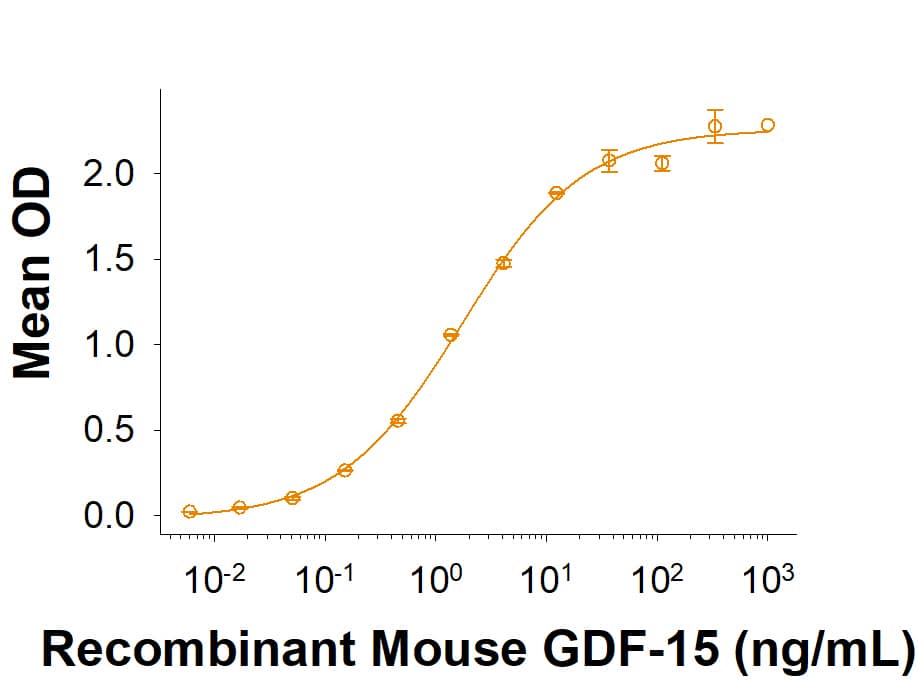Recombinant Mouse GDF-15 (CHO-expressed) Protein, CF
R&D Systems, part of Bio-Techne | Catalog # 10596-GD

Key Product Details
Source
CHO
Accession #
Structure / Form
Disulfide-linked homodimer
Conjugate
Unconjugated
Applications
Bioactivity
Product Specifications
Source
Chinese Hamster Ovary cell line, CHO-derived mouse GDF-15 protein
Ser189-Ala303
Ser189-Ala303
Purity
>95%, by SDS-PAGE under reducing conditions and visualized by silver stain.
Endotoxin Level
<0.10 EU per 1 μg of the protein by the LAL method.
N-terminal Sequence Analysis
Ser189
Predicted Molecular Mass
13 kDa
SDS-PAGE
11-13 kDa, under reducing conditions,
Activity
Measured by its binding ability in a functional ELISA.
Recombinant Mouse GDF-15 (CHO-expressed) (Catalog # 10596-GD) binds to Recombinant Mouse GFR alpha-like Fc Chimera (Catalog # 9844-GR) with an ED50 of 0.500-5.00 ng/mL.
Recombinant Mouse GDF-15 (CHO-expressed) (Catalog # 10596-GD) binds to Recombinant Mouse GFR alpha-like Fc Chimera (Catalog # 9844-GR) with an ED50 of 0.500-5.00 ng/mL.
Scientific Data Images for Recombinant Mouse GDF-15 (CHO-expressed) Protein, CF
Recombinant Mouse GDF‑15 (CHO-expressed) Protein Binding Activity.
In a functional ELISA, Recombinant Mouse GDF-15 (CHO-expressed) (Catalog # 10596-GD) binds to Recombinant Mouse GFR alpha-like Fc Chimera (9844-GR) with an ED50 of 0.500-5.00 ng/mL.Recombinant Mouse GDF-15 (CHO-expressed) Protein Bioactivity.
Recombinant Mouse GDF-15 (Catalog # 10596-GD) activates SRE-SEAP reporter in HEK293 human embryonic kidney cells transfected with human c-Ret and human GFRAL.Recombinant Mouse GDF-15 (CHO-expressed) Protein SDS-PAGE.
1 μg/lane of Recombinant Mouse GDF-15 (CHO-expressed) Protein (Catalog # 10596-GD) was resolved with SDS-PAGE under reducing (R) and non-reducing (NR) conditions and visualized by silver staining, showing bands at 11-13 kDa and 22-26 kDa, respectively.Formulation, Preparation and Storage
10596-GD
| Formulation | Lyophilized from a 0.2 μm filtered solution in HCl. |
| Reconstitution | Reconstitute at 500 μg/mL in 4 mM HCl. |
| Shipping | The product is shipped with polar packs. Upon receipt, store it immediately at the temperature recommended below. |
| Stability & Storage | Use a manual defrost freezer and avoid repeated freeze-thaw cycles.
|
Background: GDF-15
References
- Bootcov, M.R. et al. (1997) Proc. Natl. Acad. Sci. USA 94:11514.
- Böttner, M. et al. (1999) Gene 237:105.
- Fairlie, W.D. et al. (1998) J. Leukoc. Biol 65:2.
- Fairlie, W.D. et al. (2001) J B.C 20:16911.
- Bauskin, A.R. et al. (2000) EMBO J. 19:2212.
- Strelau, J. et al. (2000) J. Neurosci. 20:8597.
- Schober, A. et al. (2001) J. Comp. Neurol. 439:32.
- Mullican, S. et al. (2017) Nat. Med 23:1150.
- Yang, L. et al. (2017) Nat. Med 23:1158.
- Emmerson, P. et al. (2017) Nat. Med 23:1215.
Long Name
Growth Differentiation Factor 15
Alternate Names
GDF15, MIC-1, NAG-1, PDF, PLAB, PTGF-beta
Gene Symbol
GDF15
UniProt
Additional GDF-15 Products
Product Documents for Recombinant Mouse GDF-15 (CHO-expressed) Protein, CF
Product Specific Notices for Recombinant Mouse GDF-15 (CHO-expressed) Protein, CF
For research use only
